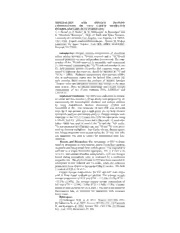
NASA Technical Reports Server (NTRS) 20120011576: Mineralogy and Oxygen Isotope Compositions of Two C-Rich Hydrated Interplanetary Dust Particles PDF
Preview NASA Technical Reports Server (NTRS) 20120011576: Mineralogy and Oxygen Isotope Compositions of Two C-Rich Hydrated Interplanetary Dust Particles
MINERALOGY AND OXYGEN ISOTOPE COMPOSITIONS OF TWO C-RICH HYDRATED INTERPLANETARY DUST PARTICLES. C. J. Snead1, L. P. Keller2, K. D. McKeegan1, S. Messenger2 and K. Nakamura-Messenger2, 1Dept. of Earth and Space Sciences, University of California, Los Angeles, Los Angeles, CA 90095- 1567, USA. E-mail: [email protected]. 2Robert M. Walker Laboratory for Space Science, Code KR, ARES, NASA/JSC, Houston, TX 77058. Introduction: Oxygen isotopic compositions of chondrites reflect mixing between a 16O-rich reservoir and a 17O,18O-rich reservoir produced via mass-independent fractionation. The com- position of the 16O-rich reservoir is reasonably well constrained [1], but material representing the 17O,18O-rich end-member is rare [2]. Self-shielding models [3] predict that cometary water, pre- sumed to represent this reservoir, should be enriched in 17O and 18O by > 200‰. Hydrated interplanetary dust particles (IDPs) rich in carbonaceous matter may be derived from comets [4]; such particles likely contain the products of reaction between 16O-poor water and anhydrous silicates that formed in the inner solar system. Here we present mineralogy and oxygen isotope compositions of two C-rich hydrated IDPs, L2083E47 and L2071E35. Analytical Conditions: The IDPs were embedded in elemen- tal sulfur and thin sections (~50 nm thick) were prepared by ul- tramicrotomy for mineralogical, chemical and isotopic analysis by using transmission electron microscopy (TEM) and NanoSIMS at JSC. The remainder of each IDP was extracted from the S and pressed into a high-purity Au for bulk electron microprobe analyses and isotopic analyses. Oxygen isotopes were measured on the UCLA Cameca ims-1270 ion microprobe using a 10KeV, 3nA Cs+ primary beam and a 10µm spot. A mass reso- lution >9000 was used to resolve the 17O and the 16OH peaks. 16O was measured on a Faraday cup, and 17O and 18O were meas- ured on electron multipliers. San Carlos olivine, Burma spinel, and Afrique magnetite were used to define the TF line, and Afri- que magnetite was used to correct for instrumental mass frac- tionation. Results and Discussion: The mineralogy of E47 is domi- nated by amorphous Si-rich material, poorly crystalline saponite, magnetite and fine-grained FeNi sulfide grains. The magnetite is confined to a single framboidal aggregate. E47 is C-rich (~16 wt.% C) and contains abundant nanoglobules. E35 was strongly heated during atmospheric entry as evidenced by a continuous magnetite rim. The phyllosilicates in E35 have been converted to amorphous Si-rich material and Fe-oxides, while the carbonate grains have been altered to fine-grained Mg-Fe oxides. The bulk C content of E35 is ~8 wt.%. Oxygen isotope compositions for E35 and E47 were meas- ured in three repeat analyses per particle. The average oxygen isotope composition of E35 was !18O = +11.8‰ ±3.5‰, !17O = +13.1‰ ±1.00‰. The average oxygen isotope composition of E47 was !18O = +2.79‰ ±3.6‰, !17O = 3.56‰ ±7.5‰. Compo- sitions of both particles fall on a slope 1 line above the terrestrial fractionation line, as predicted for interaction with cometary heavy water. References: [1] McKeegan K.D. et al. 2011. Science 332:1528–1532. [2] Sakamoto N. et al. 2007. Science 317:231-232. [3] Yurimoto H. and Kuramoto K. 2004. Science 305: 1763-1766. [4] Thomas K.L. et al. 1992. Meteoritics 27: 296.
